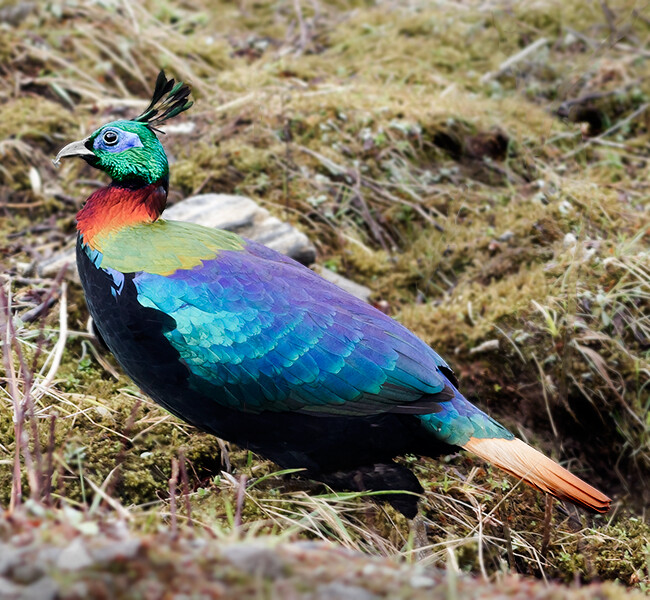

They start breeding in their second year. These pheasants breed well in captivity and usually make attentive parents. They do best on sandy soil that satisfies their need for digging, but do be sure to keep it dry. They are strong diggers and will often destroy the grass, shrubs and other greenery in the aviary. (~34 m2) – this being said, if you have the resources and land for large aviaries do keep in mind that larger is always better. These large pheasants should be provided spacious and well-drained aviaries with the following recommended dimensions: 112 sq.ft. They can tolerate cold weather very well, but need plenty of shelter and shade from the hot summer sun as they are birds from the cool mountain forests and unable to withstand extreme heat. As they are endemic to high altitudes they are very hardy birds. Most breeders keep these pheasant in pairs or even trios. Despite their large size, they are gentle birds and many may become very trusting, especially the hens.

These striking pheasants are well established and commonly seen in aviculture. This pheasant was named after Lady Impey who first kept these pheasants in captivity.Based on the Himalayan Monal pheasant’s strong association with local folklore, this pheasant has been declared as the national bird of Nepal and the state bird of Uttaranchal and Himachal Pradesh in India.They are great diggers, and use their heavy bills to root out tubers and subterranean insects. The birds have a shrill whistle, sometimes described as curlew-like. Immature birds are less distinctly marked and resemble females.
#HIMALAYAN MONAL PHEASANT SIZE PATCH#
Hens also have the blue patch around the eyes. The lower tail coverts of females are white, barred with black and rufous. Her throat is white and she has a short crest. Their upper parts are covered with mottled brownish-black feathers.
#HIMALAYAN MONAL PHEASANT SIZE SKIN#
The male also has a bare patch of turquoise blue skin around the eye.įirst year males resemble the hens, but are largerįirst year males and immatures resemble females, except for males being larger and they have black feathers on the neck and breast.įemales, while considerably duller than the males, are still quite attractive. The breast and underparts are black and the tail is copper. The males also have a large white patch on the rump. The tail feathers are uniformly rufous being darker towards the tips. The adult male has a long, metallic-green crest, much like a peacock, changeable reddish copper on the back and sides of the neck and a prominent white back and rump while in flight. The male’s impressive display features bowing and vigorous waving of the rufous tail, but it is the iridescent plumage on the wings and neck that give the bird its reputation as the “nine-colored bird” consisting of interspersing mix of metallic colors of green, purple, red and blue. Females tend to be slightly smaller and lighter. It is a relatively large sized bird averaging 2.3 feet (~70 cm) in length, the weight of males and females range between 4.4 and 5.2 lbs (1980 gram – 2 380 gram respectively). These pheasants are amongst the most beautiful pheasants due to their striking metallic-colored plumage. Males had been under heavy hunting pressure for its crest feather, which was used to ornament hats of Himachal men, until 1982 when legal hunting was banned in the state.Ī recent survey carried out in Arunachal Pradesh discovered a new type of Lophophorus species and its identity, though believed to be a subspecies of Sclater’s monal or a potential new species, is yet to be confirmed. The status of this pheasant is still fairly secure, although its cousin the Chinese Monal is classified as threatened due to poaching and other anthropogenic factors. This species is considered stable throughout much of its range, but may have been eliminated in Afghanistan. Outside that season, they tend to form large coveys and involve in communal roosting. They are usually seen in pairs during the breeding season, which is from April to August. These pheasants exhibit great tolerance to snow and are often seen digging in it foraging for food They seem to exhibit clear and fluctuating altitudinal migration moving down as low as 6,500 feet in winter and up to 16,000 feet in the summer. These pheasants prefer cool upper temperate oak-conifer forests interspersed with open grassy slopes, cliffs and alpine meadows mostly at 9,000 to 10,000 ft elevations. There is also a report of its occurrence in Myanmar. They can be found in Bhutan and countries of Pakistan, India (states of Jammu and Kashmir, Himachal Pradesh, Uttaranchal, Sikkim and Arunachal Pradesh), Nepal, and Southern Tibet. They are endemic to the Himalayas, eastern Afghanistan to western China. The Himalayan Monal Pheasant ( Lophophorus impejanus) is also regionally known as the Impeyan Monal or Impeyan Pheasant. Keeping and Breeding the Himalayan Monal Pheasant


 0 kommentar(er)
0 kommentar(er)
